If you’ve ever gone shopping for an instrument, you have likely experienced the overwhelming feeling of having countless options from which to choose. A trending instrument as of late is the traditional ukulele, an instantly recognizable instrument that can be quite a joy to play. Over the last few decades, the ukulele has continued to be heard and seen in mainstream music and media, inspiring instrument makers worldwide to create various types.
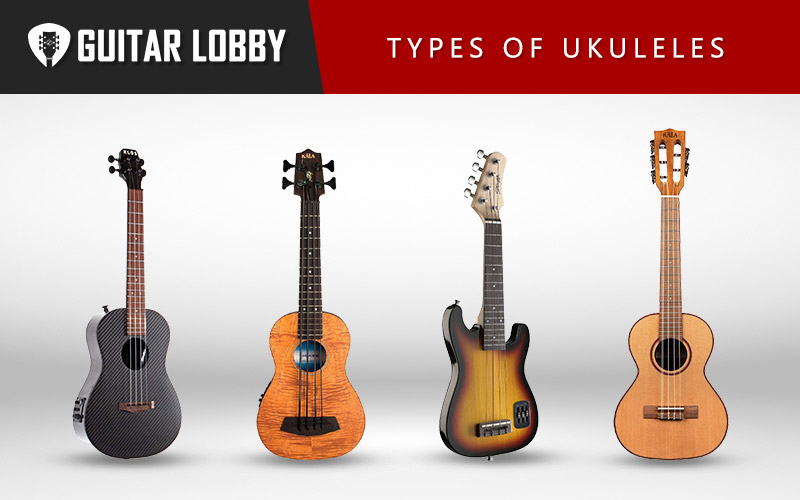
Ukuleles can be found in multiple shapes, materials, colors, and with special features and additions. In this article, we will examine the different types of ukuleles out there and how they differ from each other. Some ukuleles are rather unique and rare, while others are more traditional and found commonly at most music shops.
Before we begin, I’d like to mention that this article is focused on ukulele types, and not necessarily sizes. Frequently, types are grouped together with ukulele sizes. For reference, the most common sizes of ukuleles from smallest to largest are the soprano, concert, tenor, and baritone ukuleles. For more on ukulele sizes, check out our full article dedicated to that topic.
Table of Contents
- Here Are the Different Types of Ukuleles
- 1. Acoustic-Electric Ukulele
- 2. Solid Body Electric Ukulele
- 3. Archtop Ukulele
- 4. Bass Ukulele
- 5. Banjolele (Banjo Ukulele)
- 6. Guitalele (Guitar Ukulele)
- 7. Harp Ukulele
- 8. Lap Steel Ukulele
- 9. Travel Ukulele
- 10. Resonator Ukulele
- 11. Super Ukulele
- 12. Tahitian Ukulele
- 13. 5-String Ukulele
- 14. 6-String Ukulele
- 15. 8-String Ukulele
- Ukulele Shapes
- Ukulele Materials
Here Are the Different Types of Ukuleles
1. Acoustic-Electric Ukulele
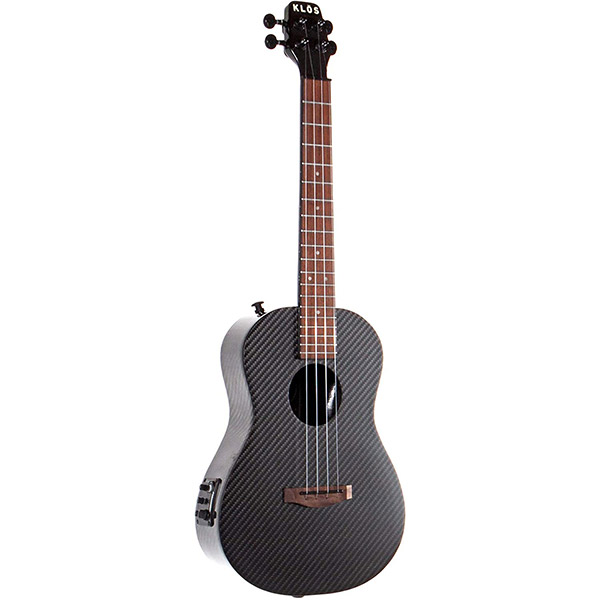
Also called the electro-acoustic ukulele, these ukuleles are standard ukes with pick-ups built into them. The body of the acoustic-electric ukulele is like a standard uke, with a hollowed-out soundbox. The difference lies in its additional ability to be amplified.
Acoustic-electric ukuleles can be played without being plugged in and will sound like a standard, acoustic ukulele. The option to amplify is there should the player wish to plug the ukulele in for perhaps a stage performance or playing with additional instruments.
Because of the extra hardware, acoustic-electric ukuleles are typically more expensive than their non-electric counterparts. You will also need an amp and cable should you wish to use them to their fullest capabilities.
2. Solid Body Electric Ukulele
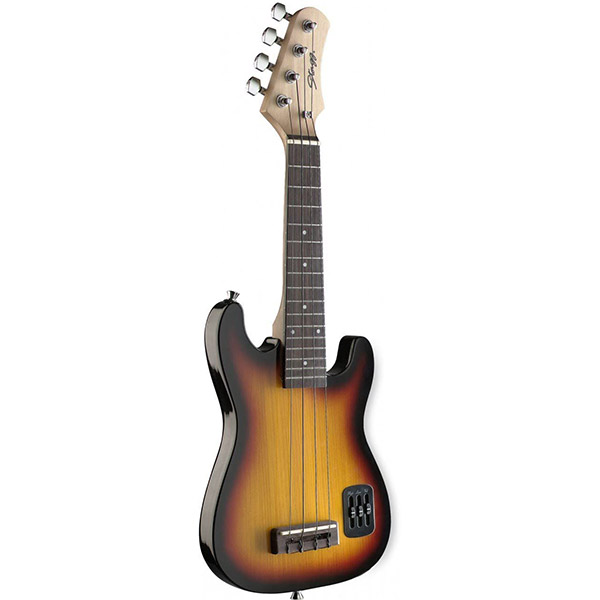
Built from a single plank of wood, solid-body electric ukuleles are made to be plugged in to play. Without amplification, these ukuleles do not project much sound at all because they are not hollowed out with a soundhole. This may be useful for some quiet late-night practicing, but not performance.
Electric ukuleles look like a smaller version of an electric guitar. Some models even emulate iconic guitar looks such as the Epiphone Les Paul, Fender Stratocaster, or the Fender Telecaster.
Because they are not crafted with a hollowed-out soundbox, electric ukuleles do lose some of the traditional sound of a ukulele. The difference in sound is similar to that of an acoustic versus an electric guitar.
3. Archtop Ukulele
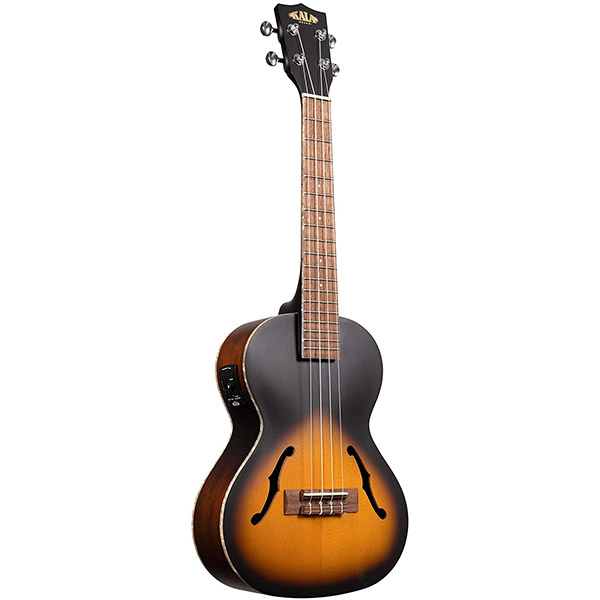
Inspired by the archtop acoustic guitar, there are also the archtop ukuleles. Archtops are curved while the traditional flattops are flat. Typically, archtop guitars have an arched top and back with a moveable, adjustable bridge. Some archtop ukulele models do as well.
Perfect for jazz and blues playing, the archtop ukulele provides a unique sound with deep, subtle nuances. The classic F-hole guitar is the inspiration for the f-hole design often included on the archtop ukulele. Offering a vintage look and feel, archtop ukuleles may be embellished with the F-holes favored in the jazz guitar world.
Archtop ukuleles are typically fitted with a pick-up Not all brands offer a ukulele of the archtop design.
Next, We’ll Discuss Hybrid Ukuleles
Due to continued advancements in technology and the development of synthetic materials, hybrid instruments have been created to provide new, unique instruments. Hybrid ukuleles are instruments that have been mixed with a ukulele. This has become a popular exploration lately, mixing the banjo, guitar, harp, and bass with the ukulele. These instruments are sometimes released in small quantities due to their special nature.
4. Bass Ukulele
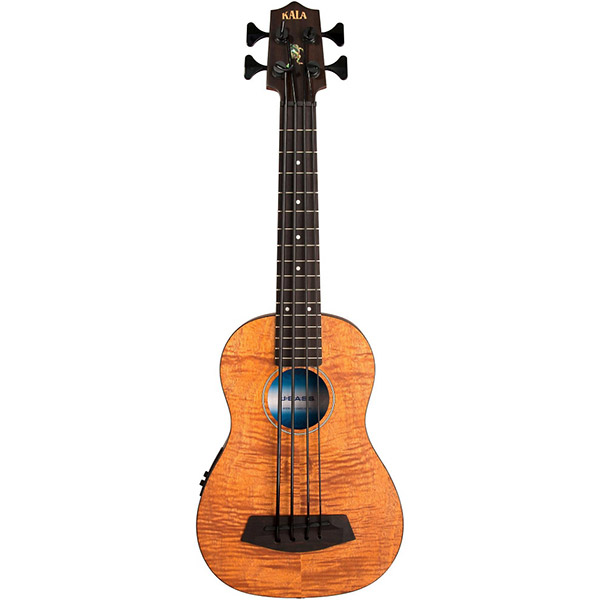
A recent invention, the first, well-known bass ukulele really hit the market in 2009 with Kala’s release of the U-Bass. Considered by some to be a novelty instrument, the bass ukulele has become a part of the ukulele family of instruments.
Depending on its body type, a bass ukulele can look like a giant ukulele or a baby bass guitar. The hollow body bass ukulele has a sound that resembles an upright bass, while a solid body bass ukulele is basically a miniature electric bass guitar. The strings are denser than regular ukulele strings, which produces those deep bass notes on the smaller instrument. The instrument has sixteen frets and can be acoustic or electric.
Bass ukuleles also have a variant ukulele called the contrabass ukulele. While the bass ukulele typically sounds an octave higher than a standard bass guitar, the contrabass ukulele is in the same octave as the standard bass guitar.
The bass ukulele is useful in ukulele orchestras, which have become increasingly popular in the last few decades. They are sold with or without frets, so be aware when ordering one for yourself if you’ve never played on a non-fretted instrument.
5. Banjolele (Banjo Ukulele)
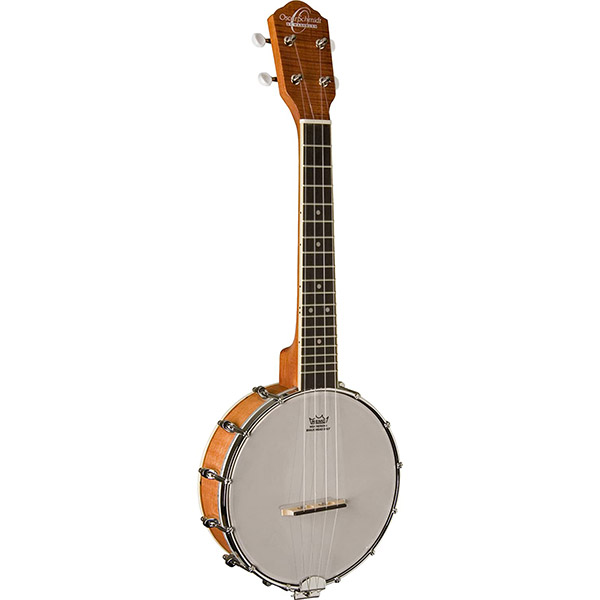
The banjolele features the string set up of a soprano uke on the body of a banjo. It was first popular in the 1920s and has continued to be manufactured. It produces a classic banjo sound with a ukulele undertone.
Typically the same scale length as a soprano ukulele, the banjolele has sixteen frets. Overall, it is constructed like a banjo on a smaller scale. Most are built of wood, although the Dixie brand featured banjo ukes made from solid metal. It is commonly tuned in C tuning, G-C-E-A, but is often tuned up to D tuning, A-D-F#-B for a more strident tone.
Because of its charm and history, pop culture loves the banjolele. A few notable banjolele players include Rebecca Sugar, Mr. B The Gentleman Rhymer, Frank Skinner, Andy Eastwood, Alan Randall, Jeff Clause, and George Harrison from The Beatles.
6. Guitalele (Guitar Ukulele)
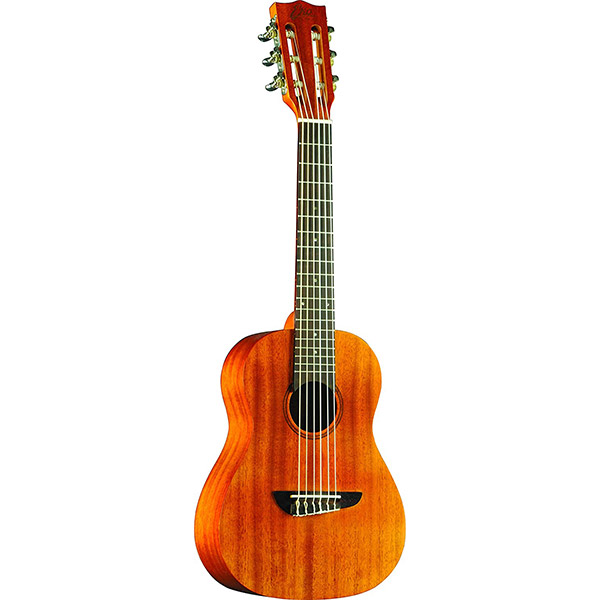
The guitar ukulele, or guitalele, is the combination of a tenor or baritone ukulele and classical guitar. It is basically played like a guitar, but the size of a ukulele. It has six strings, a small body, and is relatively common for a hybrid instrument. The size makes it more portable than a guitar, and easier to play for children interested in playing guitar.
The tuning of a guitalele is in the same intervals as a guitar but transposed up a fourth. While a guitar is tuned E-A-D-G-B-E from top to bottom, the guitalele is tuned A-D-G-C-E-A. This means that the guitalele will use the same chord shapes as the guitar, but the notes will sound higher, matching the guitar with the capo on the fifth fret. The guitalele is well-suited for either picking or strumming, offering the same versatility as a guitar.
7. Harp Ukulele
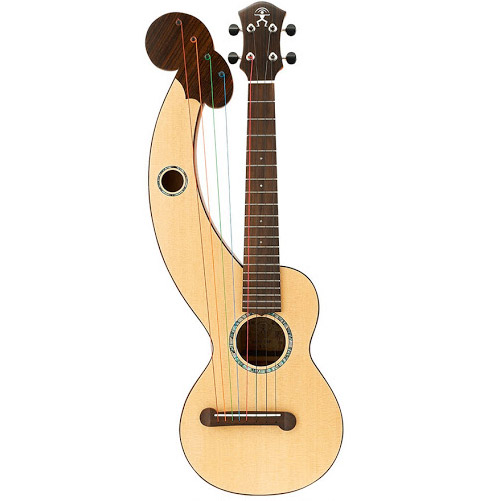
Combining elements of a harp and ukulele, the harp ukulele was first developed in the 1910s when the harp guitar was experiencing some popularity. There are numerous ways the aspects of the two instruments have been combined. The two main variants are the string-less extended bout type and the unfretted string extension, forming a miniature harp guitar.
The harp ukulele is very distinguishable by its shape with an additional arm attached for the harp strings, although not always. The added harp strings are meant to be played open, while the ukulele strings can still be fretted as normal. The number of harp strings added varies depending on the maker of the ukulele.
The harp ukulele is an uncommon instrument and rare to come across, although there are luthiers experimenting with the design. There are electric harp ukuleles as well as acoustic. Levers can be added for the harp strings, often called sharpening levers, to add semitones. This is one of the most unique types of ukuleles out there.
8. Lap Steel Ukulele
Distinguished by the style in which it is played, the lap steel ukulele combines characteristics of the lap steel guitar with the ukulele. It features raised strings at both the nut and bridge ends of the fretboard. The frets are unusable and are sometimes replaced with markers on some ukes. They generally have four strings and a square neck.
To play it, the lap steel ukulele is either placed on the player’s lap or a surface in front of them. The player holds a metal slide, called a steel, in their left hand which is moved along the strings rather than pressing them down into frets. This changes the pitch while the right hand plucks or picks the strings. Because of the playing technique, this instrument is also referred to as the slide ukulele or the uksteel.
Resonator ukuleles are sometimes grouped into this category, but because the approach to playing them is different, resonator ukuleles will be discussed separately. Notable lap steel ukulele players include James Hill, Debashish Bhattacharya, and Del Rey.
Here Are Some Additional Types
The following options are also available for consumers when searching for the right ukulele. Each of these more unique variants fits a specific niche, but you may find that one of these options suits you better than those previously mentioned. While they share few similarities, each of these instruments is useful in its own way.
9. Travel Ukulele
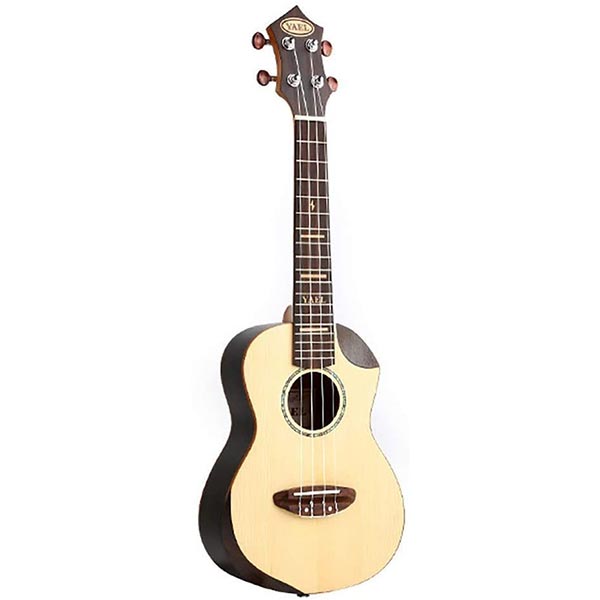
With modern traveling capabilities, ukuleles are able to travel the world. While a standard ukulele is rather portable, many ukulele makers have started to offer the travel ukulele. Regular ukuleles can be fragile and at a higher risk of taking damage when being transported in a car or airplane. A travel ukulele is designed to be more compact and durable for musicians on-the-go.
The main feature of a travel ukulele is the thinner body. While a standard ukulele is 3.5-4 inches thick, travel ukuleles are typically 1.5-2.5 inches thick. The reduced size makes it possible to put your travel ukulele in a backpack or carry-on bag.
Due to the thinner body, the travel ukulele will produce less volume and have a less deep sound. They also tend to be more expensive because they are built more compactly, which requires precision. Travel ukuleles can be made of wood, laminate, or plastic and also include thin body and backpacker ukuleles. Some travel ukuleles have unique shapes while others keep the traditional shape, but thinner.
10. Resonator Ukulele
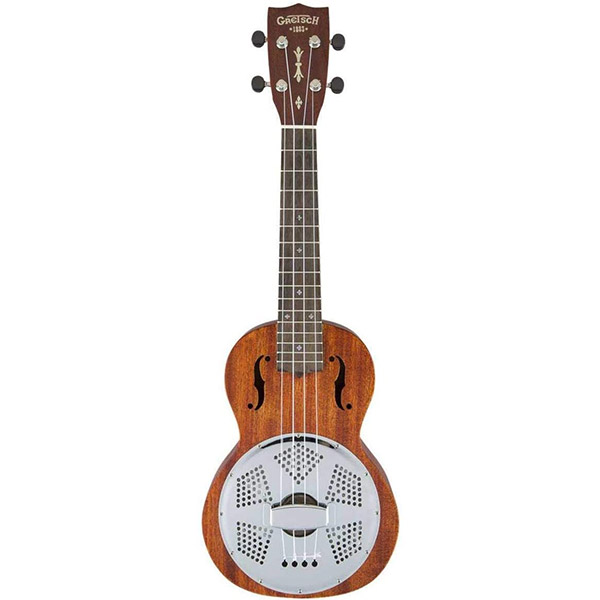
A descendent of the resonator guitar, the resonator ukulele, or resophonic ukulele, is one in which the sound is produced by one or more spun aluminum cones, called resonators, rather than the traditional wooden soundboard. These cones serve as speaker cones and make the ukulele generally louder with a distinctive tone and appearance.
Resonator ukuleles can be made from metal, fiberglass, wood, or a combination of materials. The metal body resonator ukes are made from brass, aluminum, or steel and are often painted. Those with wooden bodies are usually stained or lacquered. Resonator ukes are commonly designed with the f-holes and often have a vintage aesthetic. They suit the blues, bluegrass, country, and jazz styles of music well.
Famous players of the resonator ukulele include Bob Brownian and Del Rey.
11. Super Ukulele
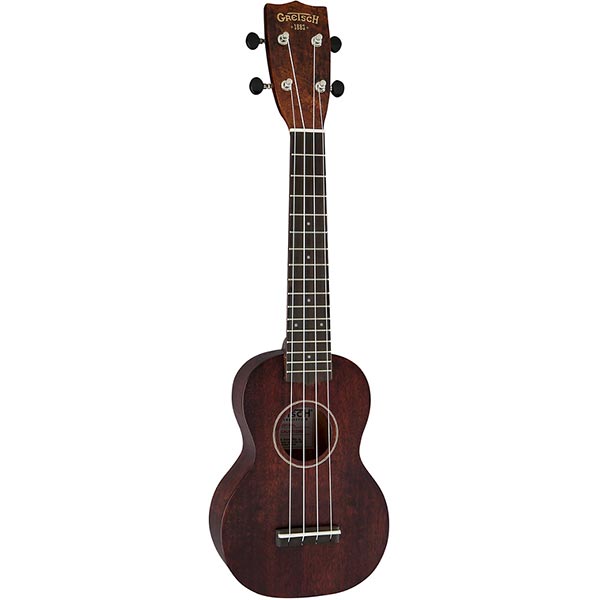
In recent years, it has become a trend to put the next size up neck on a ukulele. This is sometimes referred to as the “long neck” or “super” version of whatever size the body of the ukulele is. For example, there are the super soprano, super concert, and super tenor ukuleles, and you may see them also listed as long neck soprano, long neck concert, and long neck tenor.
A super soprano ukulele is a soprano sized body with a concert-length neck. This is beneficial to adding frets while keeping the soprano sound. The super concert ukulele is built with a tenor neck, and the super tenor is built with a baritone neck. In all of these, you are essentially giving the instrument more frets to play. This is beneficial for playing music high up on the fretboard and for soloing.
12. Tahitian Ukulele
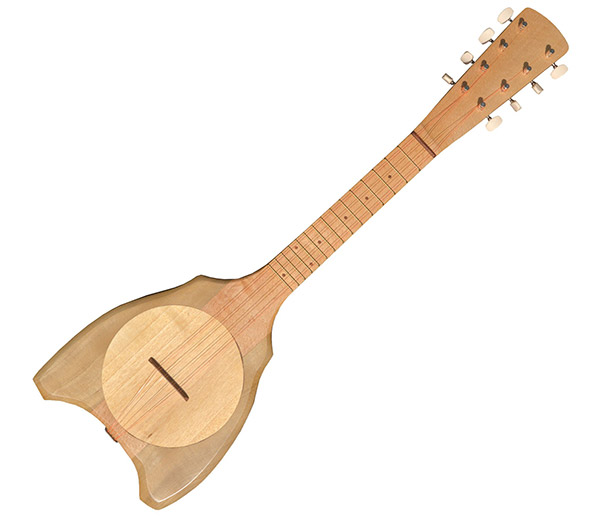
Native to Tahiti and played in regions of Polynesia, the Tahitian ukulele is a variant of the older Hawaiian ukulele. It is sometimes classified as a short-necked fretted lute and is also called the Tahitian banjo or Polynesian ukulele
A significant difference in the Tahitian ukulele from other ukuleles is that it does not have a hollow soundbox. The body, head, and neck are carved from a single piece of wood, and it has eight strings in four doubled courses. . It offers a higher, thinner sound and has an open back. A wide conical hole is bored through the middle, and the instrument functions much like a wood-topped banjo. It has eight strings with four double courses.
Beyond Four Strings
The traditional, standard ukulele has four strings. From top to bottom, the standard four string’s notes are G-C-E-A. Unlike the guitar, the ukulele is not tuned from lowest to highest when following the strings from top to bottom. The top string, G, is usually higher in sound than the second string, C. Then the E string is in between the two, and the A string on the bottom is the highest. Simply put, it goes low-lowest-high-highest from the top G string to the bottom A-string.
There are ukuleles that expand upon these four strings by adding additional strings. Each of the following variants contains the standard four notes in addition to their own additional notes to allow for more variety in playing or for creating bigger, deeper tones.
Sometimes these extra strings are grouped together with other strings in what is called a course. Basically, a course is when two strings are tightly spaced together and played together as one. These double coursed strings are played with one finger on the fretboard. This will be useful to knowledge going forward since the following ukuleles will feature doubled courses.
13. 5-String Ukulele
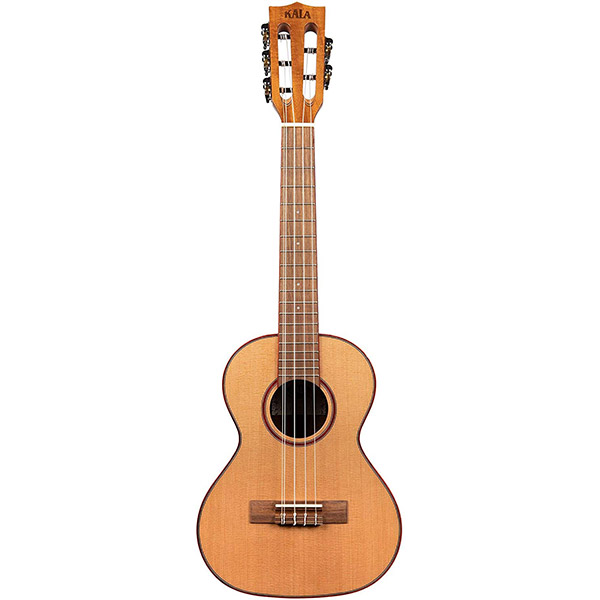
The 5-string ukulele is the most similar to the basic 4-string in that it is built similarly, but with the addition of only a single string. Commonly, this is seen as a second G string, right beside the first in a doubled course. The two G strings are to be tuned one octave apart. This serves to give the 5-string ukulele a more “full” sound with the added low G and is useful because the G note is used very often in Ukulele music. While it is possible to pick one of the two strings instead of playing both, the common practice is to play both strings together as one.
The 5-string ukulele is a fairly new concept, but it is steadily growing in popularity, thanks to that second G string. Before the 5-string ukulele’s conception, many 4-string players debated what the best way to tune their instrument was; some swore by the low G, but yet others preferred the high. While the debate is still ongoing, 5-string ukulele players no longer need to worry, as this problem is neatly solved with this iteration.
14. 6-String Ukulele
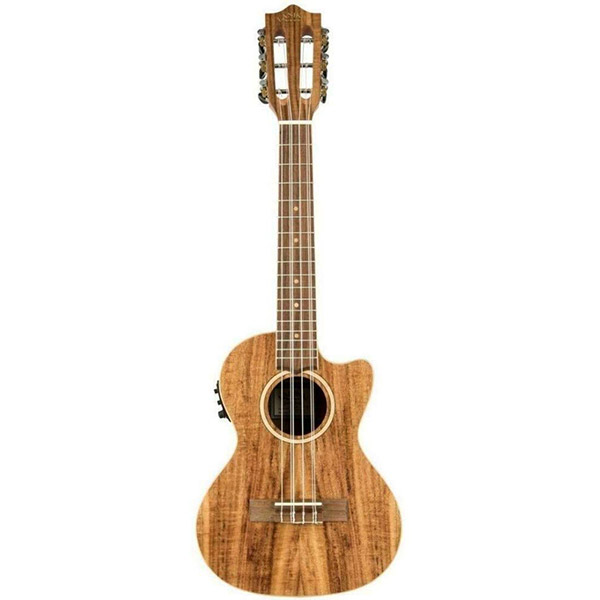
There are two common types of the 6-string ukulele. One is strung similarly to the 4-string and 5-string ukes, but with its six strings over four courses. The other is the “guitalele”, named for its close resemblance to the guitar. The guitalele has its six strings over six separate courses, giving the user a broader range of notes to work with. The guitalele was mentioned earlier in this article as a hybrid instrument.
The main goal of the 6-string ukulele with four courses (not the guitalele) is to enrich the sound of the basic 4-string ukulele. Typically, the C and A strings are doubled, for six strings total over four courses. These can be either higher or lower than the originals, but typically the C’s are tuned in octaves while the A’s are tuned in unison. This variant of the 6-string ukulele is great for strumming in Hawaiian music like its parent instrument and will use the same chord shapes as the traditional, 4-string ukulele.
15. 8-String Ukulele
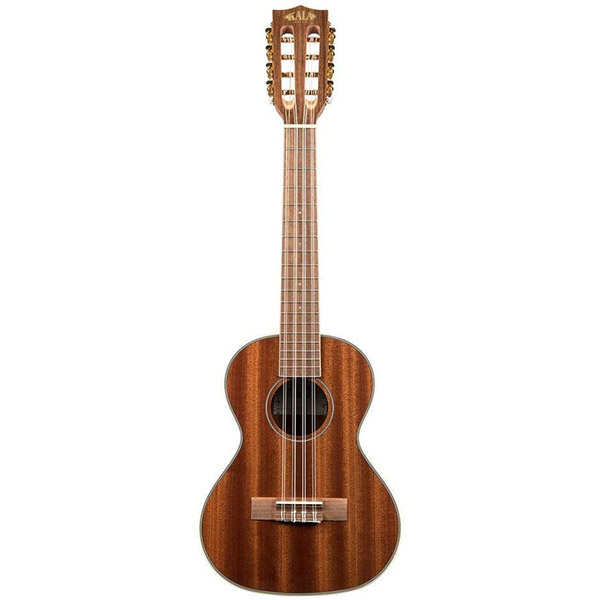
While there are other variations, the common 8-string is set up with its strings separated evenly over four courses, similar to the basic 4-string, and the four-course variant of the 6-string ukulele. Usually, the strings will be tuned with the two G strings set an octave apart, as well as the two C strings. The two pairs of E and A strings, on the other hand, are often tuned to the same pitch as one another. This method of tuning keeps the ukulele’s iconic sound while enriching it, more so than any of the smaller options.
There are many other possible ways to tune the 8-string variant, but most players recommend experimentation, like with the four-course, 6-string ukulele. Like that instrument and its 5-string cousin, the 8-string variant is usually used for strumming. While picking with the 8-string is possible, it is quite difficult, compared to picking on a mandolin, as the two instruments are set up very similarly.
Popular Related Article: The Best Beginner Ukuleles (All Price Ranges)
Ukulele Shapes
There are three common shapes seen in the ukulele world: the traditional figure eight, the oval pineapple ukulele, and the cutaway ukulele.
Traditional
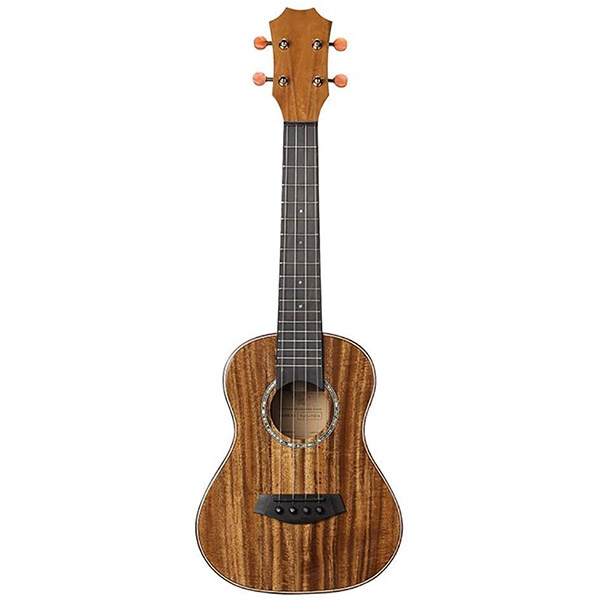
Based on the figure-eight shape of the guitar, the traditional ukulele shape is the most common. The two inward curves on the top and bottom give it the signature figure-eight shape shared with its guitar relative.
This is the standard shape of the ukulele and is the most commonly found. Depending on the type, some traditional shapes are wider at the bottom while others are symmetrical.
Popular Related Article: The Best Ukulele Brands (Our Favorites)
Pineapple Ukulele
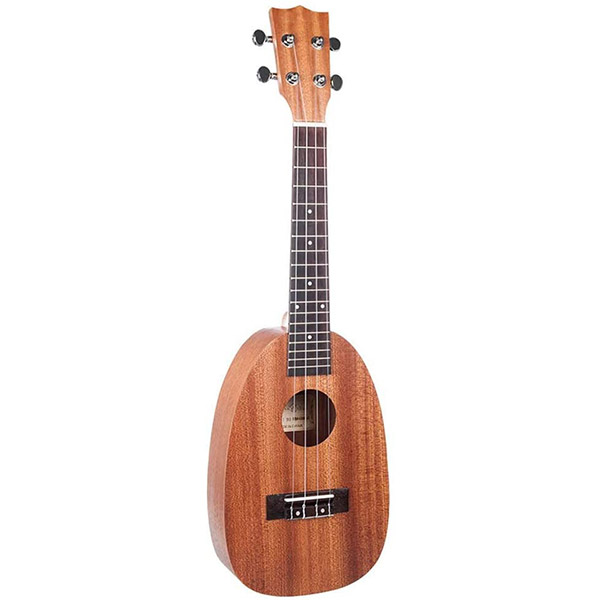
Because of its larger front and back panels along with an overall larger body, the pineapple ukulele is considered to have a louder, more mellow sound. Pineapple ukuleles have oval-shaped bodies and offer a Hawaiian aesthetic.
Nowadays, many ukulele brands and makers offer at least one pineapple ukulele line. Some even take it further and offer fun patterns, designs, and colors.
Cutaway Ukulele
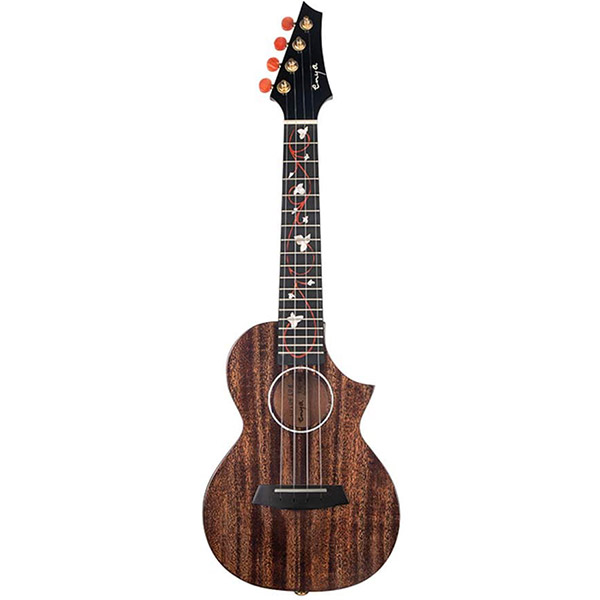
Guitars and ukuleles can also be found with a special shape called the cutaway. The cutaway ukulele literally has a part of the body “cutaway” for easier access to the higher frets. Many find the shape to be stylish as well.
Cutaway ukuleles are usually found in the tenor size and are usually slightly more expensive due to their aesthetic draw, as many musicians find the cutaway to look cool.
Ukulele Materials
The materials from which a ukulele is crafted are numerous. While wood is the most common, it is not exclusive, and there are dozens of types of woods available. The sound, appearance, and purpose of the ukulele are influenced by what it is made from, so let’s take a look at some options.
Laminate vs. Solid Top vs. Solid Wood
First, ukuleles made from wood can be of solid wood, laminate, or a solid top with laminate elsewhere. Solid wood ukuleles are of higher quality and higher price and are created using a single layer of wood in order to generate a vibrant, resonant sound. They are more expensive and less durable, as solid wood is more sensitive to temperature and humidity, so they require more care and maintenance. High-end ukuleles are usually constructed of solid wood.
Laminate is the use of several thin layers of wood merged together to create the instrument. It is more affordable and durable, making laminate ukuleles a good option for beginners. Laminate does not sound as good as solid wood, however, it doesn’t necessarily sound bad when the ukulele is constructed well. Recently, ukulele makers have also started using a special material called “high-pressure laminate”, or HPL. Essentially, it is a higher quality laminate favored for its incredible durability and resistance to water.
Solid wood top ukuleles are exactly what the name implies. The soundboard, or top of the ukulele where the strings are, is made of solid wood, while the remainder of the ukulele is laminate.
Ukulele Tonewoods
The wood used to build a ukulele is a vital element to the sound of the instrument. Each type of tonewood affects how the instrument sounds and can be used in combination or exclusively in the construction of a ukulele. Preferences play a part in choosing the tonewood a player wants, so here are brief descriptions of each tonewood used in ukulele crafting.
Koa
Koa is also called acacia kia and is an exotic wood that grows naturally in Hawaii. The sound produced by koa is top-notch with a straightforward, mellow sound with excellent sustain and the grain is quite aesthetically pleasing. Koa ukuleles are high-end and therefore are more expensive.
Mango
Originated from India, mango wood isn’t as common as it once was, however, it is used in ukulele construction for its durability and value. It boosts bright tones and is available in a variety of grains.
Mahogany
Mahogany brings out the mid-range of the ukulele and is a great choice for a balanced sound for various types of music. Many ukulele necks are made of mahogany, and it can be found used on the top, back, and sides. Solid mahogany body ukes are a great choice and are often a budget-friendly option.
Spruce
Crisp and highly resonant, spruce produces the loudest sound of the tonewoods. It is a light-colored wood and offers well-balanced tones.
Rosewood
One of the strongest tonewoods, rosewood is a high-density wood with an attractive grain finish. Ukuleles made with rosewood offer a warm, rounded sound with long sustain and deep lows. The main two types of rosewood are Brazilian and Indian, with the latter being darker and less grained.
Cedar
Producing warm, soft, dark tones, cedar is considered a great choice for fingerstyle playing. It is commonly used in soundboards and appears as darker reddish-brown.
Maple
Offering clarity and resonance, maple amplifies high frequencies and is often paired with other woods such as spruce. Maple is commonly used for the backs and sides of a ukulele. Its gorgeous grain is also used in artistic ukuleles.
Metal
The hardware that comprises the tuning mechanisms and frets of a ukulele can be made from various metals including chrome, brass, and nickel. There are also special ukulele types that use metal in more than just the hardware such as resonator ukuleles and lap steel ukuleles, which will be explored more in-depth in later sections.
Plastic and Fiberglass
Some ukulele makers will offer ukuleles constructed partially or entirely of plastic or fiberglass. While these won’t offer the same, beautiful tones like wood, they are great for travel ukuleles or for children due to their durability and resistance to humidity or temperature changes.
A fairly new addition to wood alternatives for uke is the carbon fiber ukulele. The polycarbonate material gives the ukulele a bright sound. It is waterproof and incredibly resistant to damage.
Popular Related Article: Easy Ukulele Songs for Beginners
Other Unique Shapes
Because there are out-of-the-box, innovative thinkers, there are of course shapes of ukuleles that are most unique in shape and are often rare to encounter. There are ukulele brands that offer unique pear, bell, peanut, and boat paddle shapes. The shape is accurately described in the name of these ukuleles.
Armadillo ukuleles are rare and interesting, using the shell of an armadillo for the back of the ukulele. Today, it is more common for it to be wood in the shape of the armadillo shell. These ukuleles are called charango in South America.
There are definitely even odder shapes out there to be found, but this section covers a majority of the shapes you may encounter when checking out ukuleles.
Ukuleles with Pickups
Several types of ukuleles are made with the ability to plug into an amp. A pick-up is an electronic unit that is used to transmit, or “pick up” the sound of the ukulele to be transferred to the amplifier. Depending on the ukulele and the maker, pick-ups can be active or passive. Active pickups have a built-in preamp, usually require a 9V battery, and have a higher output because they rely on a power source. Passive pickups are the original design and have no built-in preamp. A passive pickup is more sensitive to feedback, but it is also simpler to operate than an active pickup. When considering a ukulele with a pickup, you may want to continue familiarizing yourself with the pros and cons of each.
Final Thoughts
Regardless of the material a ukulele is made from, the build and craftsmanship are highly influential on the quality, sound, and longevity of your instrument. Be certain to research brands for their reputation and warranties.
Deciding what type of ukulele is best is an individual choice based on the purpose of the instrument and personal preference. A beginning player may wish to have a basic, traditional ukulele while a professional or collector may be interested in hybrid or specialty instruments. Performers may require amplification, while hobbyists might pass on that feature. The best thing to do if you are exploring is to list what features appeal most to you as a player, and get out there and try the types that best fit your musical wants and needs. After viewing what types there are in this article, hopefully, you now have a better idea of where to begin. Happy strumming!

My name is Chris and I’ve had a passion for music and guitars for as long as I can remember. I started this website with some of my friends who are musicians, music teachers, gear heads, and music enthusiasts so we could provide high-quality guitar and music-related content.
I’ve been playing guitar since I was 13 years old and am an avid collector. Amps, pedals, guitars, bass, drums, microphones, studio, and recording gear, I love it all.
I was born and raised in Western Pennsylvania. My background is in Electrical Engineering, earning a Bachelor’s degree from Youngstown State University. With my engineering experience, I’ve developed as a designer of guitar amplifiers and effects. A true passion of mine, I’ve designed, built, and repaired a wide range of guitar amps and electronics. Here at the Guitar Lobby, our aim is to share our passion for Music and gear with the rest of the music community.
